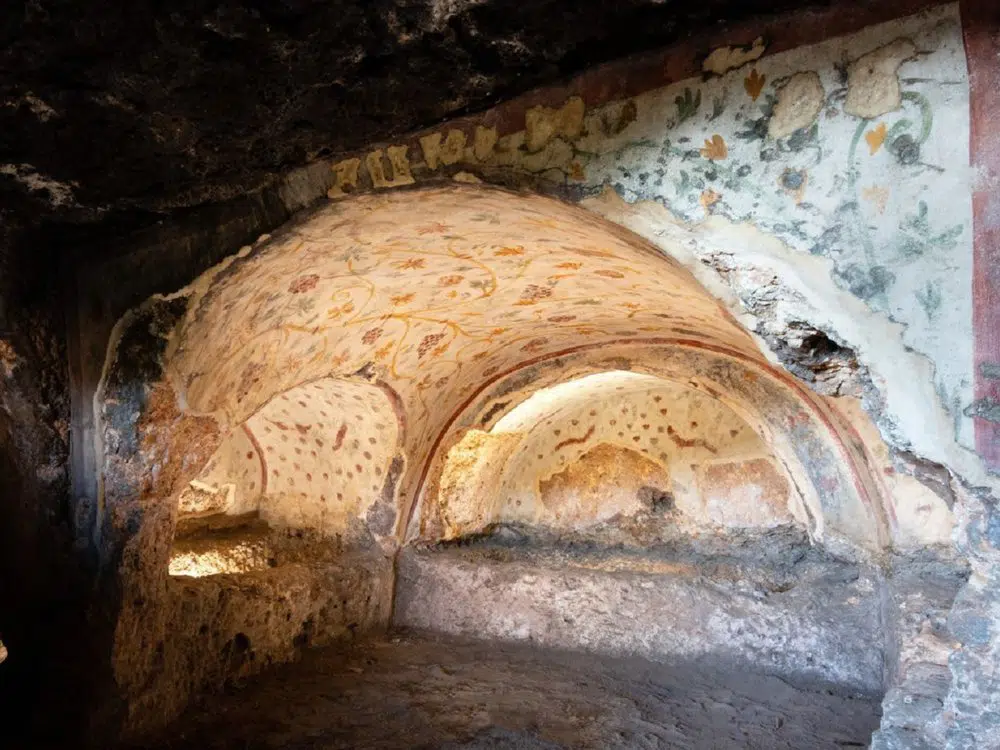
Archaeologists are feverishly uncovering and studying hundreds of ornate, rock-cut tombs carved out of a towering cliff in Blaundos, Uşak, Turkey, a city that was named after a commander in the army of Alexander the Great.
Inhabited for centuries by Macedonians, the area was later an important Roman city, serving as a center for Christian worship in Byzantine times near the larger city of Ousakeion.
First systematically excavated in 2018, archeologists are still continuing to uncover the beautifully painted rock tombs, which at one time were carved into the cliff in a canyon and which once had their own doors made of marble.
The city was located strategically atop a hill with nearly 365-degree views of the surrounding countryside, which would have made it extremely difficult to take by force.
The tombs feature colorful floral art depicting mythological figures, flowers, vines, and grapes along with geometrical patterns, according to a report from Smithsonian Magazine.
A total of four hundred tombs, dating back to 1,800 years ago, when the ancient city was part of the Roman Empire, were painstakingly carved into the face of the cliff.
Although known to the outside world as far back as 150 years ago, there had not been any official research at the site until 2018, when archaeologists who were part of the Blaundos Archaeological Excavation Project began their work.
The Daily Sabah reports that the team has found temples, a theater, a public bath, aqueducts, a public building, a stadium, and other constructions in the ancient city.
Oil lamps lit in ancient rock-cut tombs to commemorate the dead
“Apart from these, we know that there are many religious, public and civil structures still under the ground,” noted expedition leader Birol Can, an archaeologist at Uşak University, in an interview.
Birol Can says: “There are arched sarcophagi carved into the bedrock in front of the walls of each room. Apart from these, places that are thought to be used for funeral ceremonies were also found inside the rock tombs. The main door of the tombs was closed with a marble door and reopened during burial or ceremony times in the past.”
Live Science reports that some of the tombs have only one chamber, but others are “complex structures formed by arranging rooms one after the other,” according to Can.
“These rooms were not created in one go,” he explains, adding “it is understood from the traces on the walls that these tombs were originally designed as a single room” that was then expanded with other rooms then added.
Unfortunately, as happens so often, looters partially destroyed some of the tombs, confiscating jewelry and other objects that had once been grave goods lovingly placed by relatives.
Tomb murals damaged by soot from shepherds’ fires
Still, however, the tombs are a treasure trove for archeologists and historians, who have found pottery and coins dating back to the second century AD as well as mirrors, rings, cups and even oil lamps, which may have been lit much like in the catacombs outside Rome with many oil lamps lit there as a way to commemorate the dead.
Painted murals which still decorate twenty-four of the burial chambers are in bad shape, the archeologist admits; however, the fact that they still exist at all may be something of a miracle.
“Some of these tombs were used as animal shelters by shepherds a long time ago,” Can told interviewers, adding that “the frescoes were covered with a dense and black soot layer due to the fires that were set in those times.”
Teams of conservators have cleaned some of the priceless frescoes, which sometimes depict figures form ancient Greek mythology, including Hermes, Eros, and Medusa, as well as animals, including birds and dogs.
The archeologists say there are still hundreds of such graves within the cliff. These remain to be systematically studied and explored by researchers. Perhaps most tantalizing of all, Can’s team also has plans to conduct DNA analysis in an effort to determine the ancestry, age, and sex of all those buried in the cliff tombs so very long ago.
See all the latest news from Greece and the world at Greekreporter.com. Contact our newsroom to report an update or send your story, photos and videos. Follow GR on Google News and subscribe here to our daily email!



